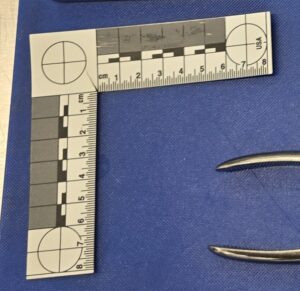WEEK FIVE: The Search Begins
Hi, Peeps!
This week was interesting. I went to the office on Wednesday, March 13th, where I attended a death investigation seminar on gunshot wounds. This was fascinating and helpful in reinforcing my preexisting knowledge of the topic. What I did that day was first go to the courthouse in Florence, Arizona, for the lecture and then go over to the medical examiner’s office to view an example of gunshot wounds in exams. Instead of being in the morgue suite, I was in the “viewing room.” I found it to be fun since I was able to look at an examination from a different perspective. It was also very interesting looking at the rest of the participants’ faces throughout the autopsy. Other than that, these upcoming weeks will be filled with learning more about the findings during an autopsy.
One of the autopsy findings I have learned about is gunshot wounds. I am now somewhat able to identify the difference between entrance and exit wounds. The reason I say “somewhat” is because sometimes it becomes quite difficult to tell the difference. There are many different factors that can change the way an entrance and/or exit wound looks, such as the pathway it took and its trajectory. A few of these factors are the projectile’s size and shape, the type of weapon, and the distance between the object and the weapon. When trying to classify the range of fire of the wound, there are certain classifications: Contact, which is close (around 0-12 inches); Intermediate, which is near (around 3-5 feet); and Distant, which is more than 5 feet.
With each different distance, there will be different characteristics of the wound. When the wound is classified as contact, it will typically have an abrasion ring, soot (aka fouling), or a stellate pattern (aka star pattern) and could possibly have a muzzle imprint. Whereas for intermediate, the muzzle is away from the body and there will be stippling/tattooing of the skin, which is caused by the burning of the gunpowder hitting the skin and marking it. And then, when classifying it as distant, there will be no visible gunpowder residue. But for distant it could also be indeterminate because if an object is between the body and the projectile, the fouling will be seen on the object and not as much on the body.
There are certain specific types of gunshot wound photographs that they have to take. They have to take three photos of each wound in the same orientation. The first picture will be taken from a distance, the second will be intermediate, and then the third will be a close-up picture, but again each will be in the same orientation. Typically, after they take the pictures, they will then take pictures with an L-shaped ruler to show the wound next to a scale. If there is hair near the area of the gunshot wound, they will shave the area to better evaluate the wound and showcase every characteristic of the wound in the pictures.


An interesting thing that I learned was that intraoral (within the mouth) gunshot wounds also need to be photographed. However, what I didn’t think about was how difficult it would be to examine and photograph the decedent’s mouth once rigor mortis sets in. What I learned was that when investigators arrive at a scene with an intraoral gunshot wound, they place a bottle between the decedent’s teeth to keep their mouth open. If they don’t take this step, rigor mortis would have most likely set in by the time they arrive at the office, making it very difficult to open their mouth. By adding a bottle beforehand, the oral cavity is kept open, making it easier to photograph and examine. I hadn’t considered this step that investigators take at the scene. What I am more curious about is: are there any more steps/processes they do at the scene?
Other than that I am excited to learn more about autopsy findings, I always look forward to learning even more things each week!
Thanks for reading!!
